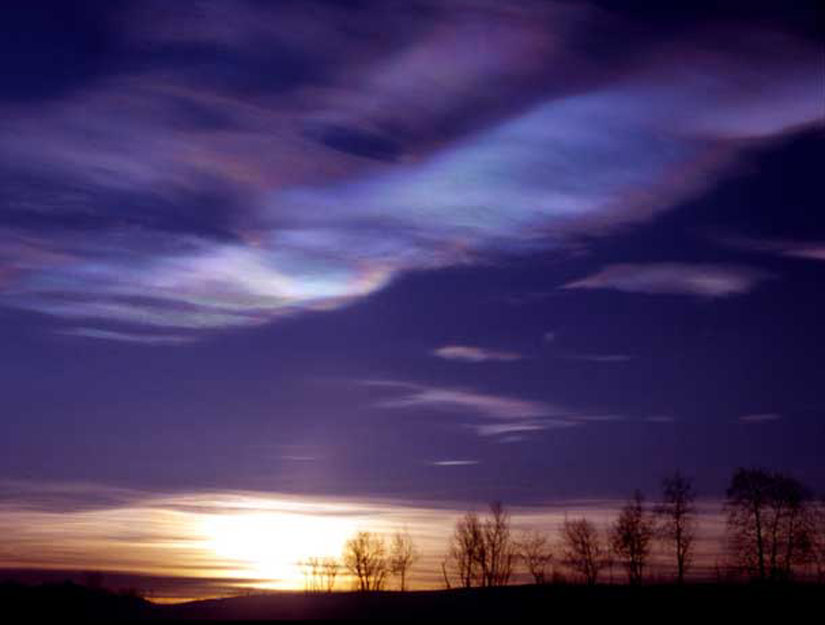
© Ross SalawitchArctic polar stratospheric clouds like these lead to ozone destruction.
The ozone hole over the south pole is a well-known phenomenon, opening up every spring, letting excess ultraviolet light stream in from the sun and driving up skin cancer risk down under.
But this year, ozone levels at the opposite pole are poised to reach record lows thanks to the right weather patterns and possibly a contribution from the changing climate."Don't panic," said Markus Rex of the Alfred Wegener Institute for Polar and Marine Research in Potsdam, Germany. "It's nothing which is a reason for great concern. Still people should have in mind that when they are outside in spring, sunburn times can drop to 20 minutes. People don't expect that in late March. You wouldn't expect to get a sunburn in the northern U.S. then."
While the ozone-depleted area is currently centered over the Arctic, the zone will shift as weather patterns change, and will pass over more populated areas as far south as about 45 degrees north -- roughly through Oregon, Minnesota and the New York-Canada border in North America -- and possibly even further.
"That system is moving around," Rex said. "Those air masses will sooner or later appear right over our own heads." The team predicts the low-levels will hover over eastern Russia by late March and will move on from there.
Rex and a global team of researchers monitoring satellite readings of ozone and temperature released the findings this week. In the past two weeks,
ozone levels in the most ozone-rich part of the stratosphere have dropped by about 50 percent, Rex said, and about 30 percent overall, which is about as low as it has ever been.
Cold stratospheric temperatures and the right weather patterns will drive levels down even further in the next few weeks, he said, leading to record lows.
Ozone depletion at both poles is caused by chlorofluorocarbons -- commonly known as CFCs and once used in air conditioners and as propellants in aerosol cans -- and other ozone-depleting substances, most of which have been phased out thanks to the 1987 Montreal Protocol, but which will persist in the stratosphere for decades to come.
The depletion happens in the stratosphere -- the upper atmospheric layer that spans from about 6 to 31 miles above Earth.
CFCs and related chemicals start wiping out ozone once stratospheric temperatures hit about -108 Fahrenheit, low enough to form wispy, shimmering clouds, sometimes called mother-of-pearl clouds, in the bone-dry stratosphere. The ice crystals inside these clouds provide surfaces for the reactions that eliminate ozone.
These reactions need a third component -- sunlight--which is why they get going at this time of year in the Arctic as the sun reappears there.
"This recent winter was a particularly cold winter" in the stratosphere, Rex said, which explains the low ozone levels.
The super-cold stratospheric temperatures are primarily the result of an unusual year of weather down closer to the ground. Normally, air moving over the various mountain ranges in the northern hemisphere disturbs the vortex of circulation around the Arctic and draws air down from the stratosphere. Both of these effects keep the polar stratosphere from getting too cold.
(The southern hemisphere is mostly ocean and therefore has much less topography, so undisturbed polar circulation is typical there, which is why the large ozone hole forms regularly there.)
"Why is the tropospheric weather different this year than it was in other years? That's extremely difficult to say," said Paul Newman of NASA Goddard Space Flight Center in Greenbelt, Md. It's probably largely just arbitrary fluctuation in the weather. Indeed, last year had unusually warm stratospheric temperatures, he said.
But climate change may also contribute, Rex said. While temperatures near the ground in the Arctic have been warming, rising levels of greenhouse gases act to cool the stratosphere -- and a cooler stratosphere means more ozone loss. This may make such lows more likely in the next 20 to 30 years, he said.
He and his collaborators are working to understand whether and how polar warming and polar stratospheric ozone are connected.
The good news is that irrespective of climate change, it is a matter of time before the problem disappears, since CFCs and other ozone-depletors are no longer entering the atmosphere in damaging quantities. Their concentrations will decline in coming decades and the ozone holes will ultimately close.
"The current winter does not change the overall picture that by the end of this century, the ozone loss will be history," Rex said.
i bet it doesnt close and i bet we see more of the same as we have been witnessing